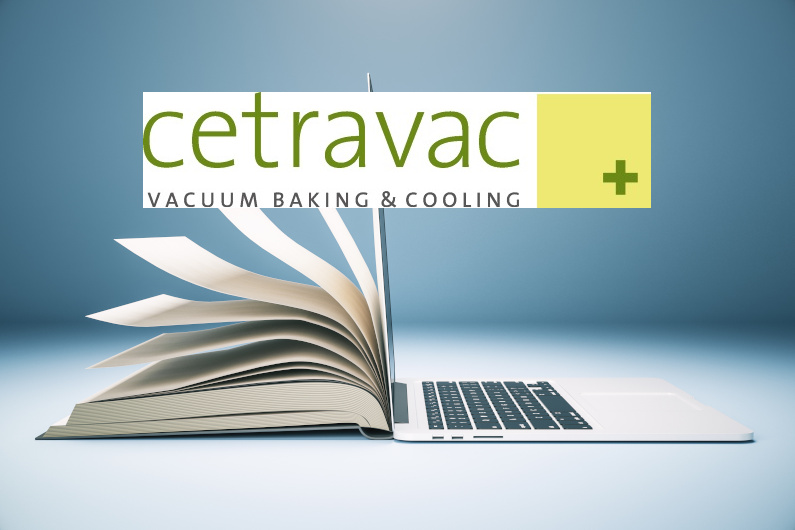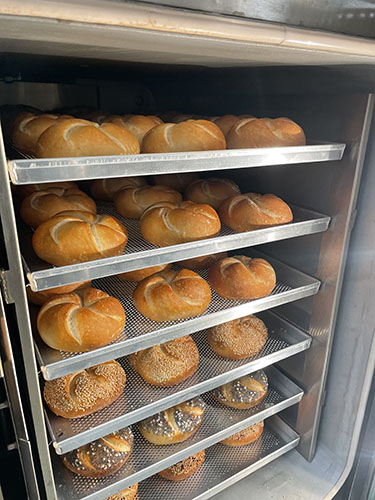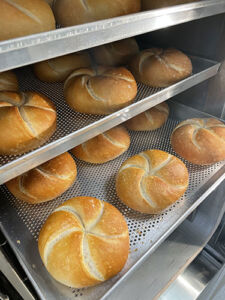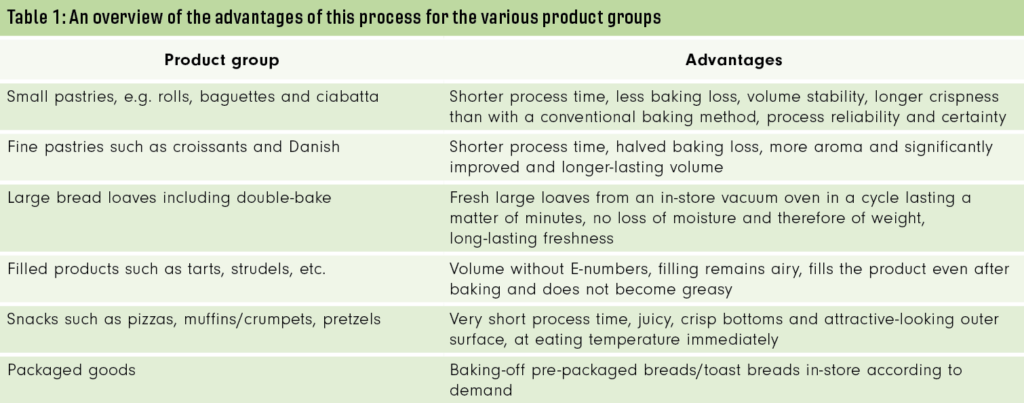
To optimize in-store baking efficiency, the UDO baking technology is one to watch. It stands for Univac Double-bake Oven and is powered by Cetravac AG’s patented innovation. Developed under the bakeXperts brand, the UDO opens the door to a new world of baking in-store.
The UDO can bake frozen, ambient-stored raw dough, or parbaked products such as rolls, baguettes and even larger loaves and cool them to perfect-to-eat level in less than 5-10 minutes. It does so while achieving perfectly even heating and retaining all product characteristics, consistently. How is such a process, which is nothing short of revolutionary, even possible? The answers are in vacuum conditioning. The process steps are straightforward: the frozen product goes into the preheated oven. In a matter of seconds, a vacuum is created, removing all air from the product’s pores and clearing the way for steam. The steam is then used to heat the product, a highly-effective process that only takes seconds and boosts crumb and crust qualities. Simultaneously, infrared radiation heating is deployed. With starch gelatinization comes heightened freshness, as this process delivers moisture to the crumb. The final step is vacuum cooling, again a seconds-long phase, which further stabilizes the structure of the baked product. The speed of the baking-off process makes it possible to react to fluctuations in demand at very short notice, thus minimizing unsold residual stocks at the end of the day.

Baking efficiency, comprehensively covered
The control system is designed so that the operators only need to place the goods on a tray, assign them to a product image and press the start button. The control system can also be integrated into other management systems such as Semco One or Shop IQ. In this way, new products can be added centrally into the interface, while also enabling comprehensive control of the oven.
“When developing the UDO vacuum baking oven, we focused on a holistic approach because it is important to us that economy and product quality are not seen as conflicting opposites.”
Adolf Cermak, founder and President, Cetravac AG and bakeXperts
There is an entire array of adjustments that can be combined to improve baking quality and efficiency. To embark on an optimization process, the goals should clearly be defined at first, before building a path to them: “What is meant by optimization, process organization, the time and effort required, the energy costs, the availability of products, or their quality? Which sub-goals are in the foreground at the same time, which can definitely vary from one company to another? When developing the UDO vacuum baking oven, we focused on a holistic approach because it is important to us that economy and product quality are not seen as conflicting opposites,” explains Adolf Cermak, founder and President of Cetravac AG and bakeXperts.
The economic perspective
Looking at the entire process, from start of production to sales, the UDO can shorten the processing time by 40-70% compared to conventional in-store baking, depending on the product, and save considerable energy and labor force requirements, respectively. In addition, it also supports raw materials savings, because baking losses are reduced to a minimum, thanks to the accurate control of the water balance in the baked goods. With this method, there is no volume or weight loss even if, initially, up to 10% less dough was used. Moreover, the stability of the process means that larger batches can be produced efficiently and quickly, with lower manufacturing costs, whereas certain products are only made in small quantities with traditional ovens to ensure their quality.
Yet another advantage of this process is that products do not usually require cold storage between initial baking, in the production facility, and final baking, in the store (depending on the duration of storage before the final preparation). “This saves refrigeration and/or freezing and the corresponding transport costs and contributes to saving energy overall,” the specialist highlights.
It is a sustainable process not only from a savings standpoint: “Since the ‘refrigerant’ in vacuum cooling is water and nothing else, it is the most ecological cooling process available today,” Cermak points out. Moreover, only products containing water can be vacuum cooled, meaning the baked goods themselves. Carrier materials (baking trays, rack trolleys, pans, etc.), which are unavoidably cooled in the conventional cooling process, are left out with vacuum cooling, which lowers the total weight of the mass that is to be cooled by approximately two-thirds. Along with this reduction, the corresponding cooling capacity or energy consumption also goes down.
Product quality considerations
Controlling water balance greatly contributes to product quality. “A 1-kg parbaked bread, for example, can be baked to completion (with a core temperature higher than 75°C) and cooled to slicing temperature within 6 to 10 minutes. It is clear that this promotes moistness and freshness for hours. Even products, in which starch retrogradation has already begun, can thereby be restored to their former freshness. The stabilization of moistness, shape and crispness immediately after baking opens up new opportunities in the highly topical market of delivery services that rely on quick availability,” Cermak adds.



Another relevant case is that of filled products such as snacks or sweet Danish pastries. When baked in conventional in-store ovens, the end product features a compacted filling, lying in a cavity. With vacuum baking, the product’s structure is preserved, hardly any cavities occur, and the product comes out of the oven with a stable volume and warm to the touch. “The visual appearance of such a pastry is completely new,” adds the company’s founder, a result that also applies to pizzas.
How efficient is vacuum baking?
When using vacuum conditioning, savings already start with the pre-baking stage, which is usually 20-25% faster than with traditional technology, for any type of product – be it a baguette, a ciabatta, or a pan bread. Vacuum technology also makes the second baking phase, which is done in-store, significantly shorter. Cermak explains: “In the UDO vacuum oven, the applied vacuum is only enough to just exceed the gelatinization temperature of the starch. Steam is then added to the baking chamber. Because the heat in the hot oven goes to the coldest point, which is inside the bread, the steam releases its heat to the crumb by condensing into water. The crumb is heated over the gelatinization temperature by absorbing the hot water. This process freshens up the crumb. In the next step, the bread is cooled by applying vacuum again and by evaporating water from the crumb down to a temperature at which it can be sliced.”
The adjoining table highlights the characteristics of different types of processes. The products pictured clearly show the positive influence that baking in a UDO has on the shape and stability of the products. With frozen dough pieces, which usually have to go into a proofer or at least be partially or fully thawed out before conventional baking, the total processing time is reduced by up to 70%. Just as importantly, the demand for the expertise of responsible employees is also minimized. The products can go from the freezer directly into the oven, without having to worry whether the proofing is perfect or not.
A patented innovation
Prof. Dr. Friedrich Meuser is an internationally renowned authority in the field of cereal and bakery technology. He commented about the process and technology developed by BakeXperts: “The oven is sensational. Cermak has approached the whole thing with an engineer’s eye, and you may ask yourself why no one has done that before him.” Meuser explains the theory and the core of the patented innovation behind the UDO: “Harry Levine and Louise Slade established the glass transition temperature theory more than 30 years ago. It states that a mixture of starch and water can change into a glass-like state at a very specific temperature. The process corresponds to a melting process in which the crystalline structure of the starch changes into a glassy state. If the glass is left to stand for a while, the starch gradually recrystallizes again. This temperature-dependent process is reversible several times, i.e. it can be repeated over and over again. The principle of the vacuum baking oven is based on the reversibility of the starch’s glass transition.”
The UDO can be used in a very wide range of applications:
+ It can bake off deep-frozen small and fine pastries, as well as bread rolls weighing less than 250 g each, considerably faster than conventional technology
+ It carries out the baking process in the shortest possible time for part-baked whole loaves with a higher unit weight (up to 1,000 g), stored at a cool or ambient temperature
+ The UDO can quickly prepare baked snacks that are also cooled down to a temperature suitable for immediate consumption
+ The UDO can be used to double-bake unsold goods from the previous day. These products can simply be baked again the next morning, and the original freshness and desired degree of crispness are restored. “For the baker, however, this also means that the range of products available for sale may well go up again the next morning, since everything can be re-baked, thanks to the UDO,” he observes.
+ It can have baked goods ready for dispatch in a matter of minutes, for delivery services or click & collect
Fresh off the drawing board
The patented UDO technology has been tested in well-known European bakeries over the past year, with positive reviews. “We have just delivered the first 25 ovens to our first customers, which are prestigious bakeries in Germany, Austria and Switzerland; and 15 more will follow in the upcoming weeks. After a testing phase of around three months, the official sales will start,” Cermak reveals.
The UDO configurations start with models for 6 to 8 baking trays, depending on tray spacing and product height. At the request of the first customers, the next model series will be a rack oven for a trolley with 10 to 18 trays, measuring 40 x 60 cm each, and a combi version with two separate baking chambers. A snack oven for pizzas and baked snacks will also go into production soon, which will be baking and vacuum cooling in under two minutes. The new oven will be the first in a series of its own.


